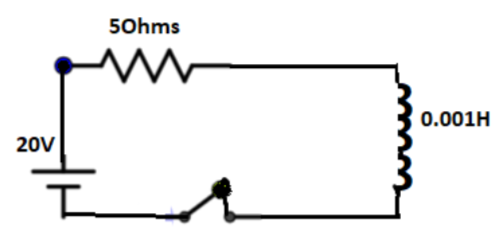
An emf of 20 V is applied at time t = 0 to a circuit containing in series a 10 mH inductor and 5 \[\Omega \] resistor. The ratio of currents at time \[t=\infty \] and \[t=40s\] is close to: (take \[{{e}^{2}}\]= 7.389 )
A). 1.06
B). 1.46
C). 1.15
D). 0.84
Answer
572.7k+ views
Hint: To solve this question we will be using the equation of current discharge for inductor – resistor circuit. For that, we must know the value of the time constant. So first, we will calculate the time constant and then solve it further. The time constant for the inductor-capacitor circuit is given by inductance over resistance. After calculating the time constant we will substitute its value in the formula for charge-discharge in the circuit and calculate the current at given time intervals.
Formula Used: \[\tau =\dfrac{L}{R}\], where
\[\tau \]= time constant in seconds.
L = inductance in henrys and R = resistance in ohms
\[i={{i}_{0}}(1-{{e}^{-{}^{t}/{}_{\tau }}})\], formula for current discharge.
Complete step-by-step solution:

We will first calculate the time constant in seconds
We know,
\[\tau =\dfrac{L}{R}\]
Substitute the given values of L and R
We get,
\[\tau =\dfrac{0.01}{5}\]
\[\tau =0.002\] sec
Now to find the current in the circuit at given time
We know,
\[i={{i}_{0}}(1-{{e}^{-{}^{t}/{}_{\tau }}})\] ……………………………… (A)
After substituting the value of time constant
We get,
\[i={{i}_{0}}(1-{{e}^{-{}^{t}/{}_{0.002}}})\]
Therefore,
\[i={{i}_{0}}(1-{{e}^{-500t}})\]
Now substitute t = 40 in above equation
We get,
\[{{i}_{40}}=\dfrac{20}{5}(1-{{e}^{-500\times 40}})\]
Therefore,
\[{{i}_{40}}=4(1-{{e}^{-20000}})\] ………………………… (1)
Similarly we will calculate the current for time t at infinity using equation (A)
\[{{i}_{\infty }}={{i}_{0}}(1-{{e}^{-\infty }})\]
\[{{i}_{\infty }}=\dfrac{20}{5}(1-0)\]
Therefore,
\[{{i}_{\infty }}=4\] ………………………………… (2)
Taking the ratio of currents
Therefore from (1) and (2)
We get,
\[\dfrac{{{i}_{\infty }}}{{{i}_{40}}}=\dfrac{1}{1-{{e}^{-20000}}}\]
\[\dfrac{{{i}_{\infty }}}{{{i}_{40}}}\cong 1\]
We have calculated the ratio which is approximately equal to 1. So, we must carefully select the answer that is closest to 1.
Therefore, the correct answer is option A.
Note: For a resistor-capacitor circuit, the time constant is taken as the product of resistance in ohms and capacitance in farads. However, for the inductor-capacitor circuit, the time constant is calculated as an inductance in henrys over resistance in ohms. This might confuse students.
Formula Used: \[\tau =\dfrac{L}{R}\], where
\[\tau \]= time constant in seconds.
L = inductance in henrys and R = resistance in ohms
\[i={{i}_{0}}(1-{{e}^{-{}^{t}/{}_{\tau }}})\], formula for current discharge.
Complete step-by-step solution:

We will first calculate the time constant in seconds
We know,
\[\tau =\dfrac{L}{R}\]
Substitute the given values of L and R
We get,
\[\tau =\dfrac{0.01}{5}\]
\[\tau =0.002\] sec
Now to find the current in the circuit at given time
We know,
\[i={{i}_{0}}(1-{{e}^{-{}^{t}/{}_{\tau }}})\] ……………………………… (A)
After substituting the value of time constant
We get,
\[i={{i}_{0}}(1-{{e}^{-{}^{t}/{}_{0.002}}})\]
Therefore,
\[i={{i}_{0}}(1-{{e}^{-500t}})\]
Now substitute t = 40 in above equation
We get,
\[{{i}_{40}}=\dfrac{20}{5}(1-{{e}^{-500\times 40}})\]
Therefore,
\[{{i}_{40}}=4(1-{{e}^{-20000}})\] ………………………… (1)
Similarly we will calculate the current for time t at infinity using equation (A)
\[{{i}_{\infty }}={{i}_{0}}(1-{{e}^{-\infty }})\]
\[{{i}_{\infty }}=\dfrac{20}{5}(1-0)\]
Therefore,
\[{{i}_{\infty }}=4\] ………………………………… (2)
Taking the ratio of currents
Therefore from (1) and (2)
We get,
\[\dfrac{{{i}_{\infty }}}{{{i}_{40}}}=\dfrac{1}{1-{{e}^{-20000}}}\]
\[\dfrac{{{i}_{\infty }}}{{{i}_{40}}}\cong 1\]
We have calculated the ratio which is approximately equal to 1. So, we must carefully select the answer that is closest to 1.
Therefore, the correct answer is option A.
Note: For a resistor-capacitor circuit, the time constant is taken as the product of resistance in ohms and capacitance in farads. However, for the inductor-capacitor circuit, the time constant is calculated as an inductance in henrys over resistance in ohms. This might confuse students.
Recently Updated Pages
A man running at a speed 5 ms is viewed in the side class 12 physics CBSE

The number of solutions in x in 02pi for which sqrt class 12 maths CBSE

State and explain Hardy Weinbergs Principle class 12 biology CBSE

Write any two methods of preparation of phenol Give class 12 chemistry CBSE

Which of the following statements is wrong a Amnion class 12 biology CBSE

Differentiate between action potential and resting class 12 biology CBSE

Trending doubts
What are the major means of transport Explain each class 12 social science CBSE

Which are the Top 10 Largest Countries of the World?

Draw a labelled sketch of the human eye class 12 physics CBSE

How much time does it take to bleed after eating p class 12 biology CBSE

Explain sex determination in humans with line diag class 12 biology CBSE

Explain sex determination in humans with the help of class 12 biology CBSE




